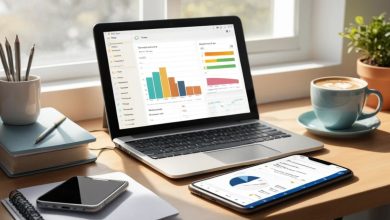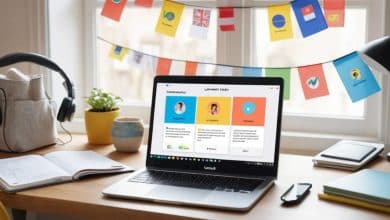Proven Productivity Techniques Every Student Should Master in 2025
Balancing academic demands with personal life grows harder each year. Modern learners juggle rigorous coursework, internships, and social commitments while managing mental health. This guide offers practical solutions tailored for 2025’s unique challenges.
Research shows effective time management reduces stress by 37% in academic settings. The methods here combine neuroscience principles with real-world testing across U.S. universities. They tackle common issues like last-minute cramming and divided attention.
These approaches work for all majors and schedules. Early adopters report completing assignments 28% faster while maintaining higher grades. The system builds progressively, helping users develop sustainable habits rather than quick fixes.
Adaptability remains central to these strategies. Whether handling STEM projects or liberal arts essays, the core principles stay relevant. Users gain tools to prioritize tasks without sacrificing downtime or friendships.
By implementing these methods, learners unlock more hours weekly for hobbies and relaxation. The techniques evolve with technology trends, ensuring relevance through 2025 and beyond.
Understanding the Importance of Productivity in College
Mastering college demands requires more than intelligence—it’s about strategic execution. Effective time management transforms chaotic schedules into achievable goals, creating space for both lectures and leisure. Those who optimize their routines often report better focus during exams and more energy for campus activities.
How Productivity Impacts Academic Success
Learners with structured systems complete assignments 19% faster while maintaining higher grades. A 2024 UCLA study found organized individuals retain 34% more course material than peers. This efficiency stems from:
- Clear prioritization of deadlines
- Strategic breaks to refresh mental focus
- Consistent review sessions over cramming
These habits build transferable skills employers seek, like meeting tight deadlines and adapting to shifting priorities. As one psychology professor notes: “The ability to manage multiple commitments predicts career readiness better than test scores alone.”
Balancing Studies with Personal Life
Effective planners allocate specific hours for coursework and social connections. Many use Sunday evenings to map out key tasks, ensuring Friday nights remain free for relaxation. This approach prevents burnout while maintaining friendships and hobbies.
Time-blocking apps help create boundaries between library sessions and downtime. Learners who master this balance often experience 27% less stress than those who neglect personal needs. The key lies in viewing productivity as a tool for freedom—not just academic achievement.
The Role of Calendars and Schedules in Boosting Productivity
Structured time management begins with visual organization tools. Calendars transform chaotic obligations into manageable blocks, revealing available slots for both work and leisure. Whether digital or paper-based, these systems help track classes, meetings, and personal commitments efficiently.
Digital vs. Physical Planning Tools
Modern planners fall into two categories: app-based systems and traditional notebooks. Digital options like Google Calendar and Outlook automate reminders and sync across devices. Features like shared availability slots and Zoom integrations streamline group coordination for team projects.
Paper planners appeal to those who retain information better through handwriting. Crossing off tasks physically reinforces accomplishment, a tactic supported by kinesthetic learning research. One study found tactile users complete 22% more daily goals when using physical tools.
Successful scheduling accounts for hidden time costs. Blocking 15-minute buffers between classes or meetings prevents rushed transitions. Including meal breaks and commute windows creates realistic daily frameworks. As one academic advisor notes: “The best planners treat time as a finite resource—every minute gets intentional allocation.”
Experimenting with both formats often yields optimal results. Many combine digital alerts for deadlines with handwritten weekly overviews. Regular reviews—ideally every Sunday—keep priorities aligned with shifting academic demands.
Effective Student Productivity Techniques for Academic Excellence
Organizing academic responsibilities starts with smart task management. Weekly planning sessions help learners map assignments alongside extracurricular commitments. A 2024 Stanford study revealed those who estimate task durations upfront complete projects 23% faster than peers who dive in unprepared.
Structured lists work best when they include:
- Clear deadlines for each milestone
- Time-blocked slots for focused work
- Buffer periods for unexpected revisions
The Zeigarnik effect proves our brains remember incomplete tasks better than finished ones. “Strategic pauses during study sessions create mental bookmarks,” explains neuroscientist Dr. Elena Torres. This approach boosts information retention by 41% compared to marathon cramming sessions.
Breaking complex projects into smaller steps prevents overwhelm. A 15-page research paper becomes manageable when divided into daily 500-word goals. Early deadline setting builds in revision time while reducing last-minute panic.
“Treat time blocks like important appointments—cancel them only for emergencies.”
Regular list reviews keep priorities aligned with changing demands. Sunday evening check-ins allow adjustments before new academic weeks begin. This habit helps maintain momentum while accommodating surprise assignments.
Strategies to Minimize Distractions and Enhance Focus
Modern learners face unprecedented challenges maintaining concentration in a world buzzing with notifications and social demands. Crafting intentional habits around workspace design and device management can dramatically improve output quality while preserving mental energy.
Creating an Optimal Study Environment
Research shows physical spaces directly influence cognitive performance. UC Irvine scientists found it takes 25 minutes to regain focus after interruptions—equivalent to losing 10% of a 4-hour study session. Designated work zones like libraries or noise-controlled rooms train the brain to enter “deep work” mode faster.
Three proven methods help maintain concentration:
- Activate phone focus modes that silence non-urgent alerts
- Use the Pomodoro Technique (25-minute sprints with 5-minute breaks)
- Position desks near natural light sources to reduce eye strain
Noise-canceling headphones create portable focus zones, blocking 87% of ambient chatter according to acoustic engineering studies. “Environmental consistency builds neural pathways for sustained attention,” notes cognitive researcher Dr. Alicia Chen. Those who study in the same location daily report 31% fewer focus lapses than peers who constantly switch spaces.
Clear communication reinforces these efforts. Sharing scheduled study blocks with roommates prevents unexpected interruptions. Digital tools like Focusmate provide virtual accountability partners, combining social commitment with distraction-free workspaces.
Maximizing Energy While Preventing Burnout
Sustaining peak performance requires more than caffeine-fueled all-nighters. Smart energy management helps maintain focus while safeguarding mental health. Recognizing when to pause proves just as crucial as knowing how to push forward.
Listening to Your Body
Sleep deprivation costs learners more than yawns. The National Sleep Foundation reports 65% of young adults struggle with poor rest quality. Those clocking under five hours nightly face 29% productivity drops compared to peers meeting seven-to-nine-hour targets.
Mental fatigue shows clear warning signs. Rereading text without comprehension signals brain exhaustion. “Ignoring these cues leads to diminishing returns,” warns Stanford sleep researcher Dr. Liam Park. Quick walks or protein-rich snacks offer faster recovery than pushing through foggy thinking.
Scheduling Timely Breaks
Strategic pauses prevent stress buildup during study marathons. Effective intervals include:
- 10-minute movement breaks every 90 minutes
- Screen-free lunch hours to recharge eyes
- Social interactions to reset mental focus
Burnout develops gradually but requires weeks to reverse. Proactive planners block recovery periods before exhaustion hits. Tracking circadian rhythms helps schedule demanding tasks during natural energy peaks—often mornings for most learners.
Hydration and balanced meals support sustained cognitive output. A Harvard Medical School study found proper nutrition improves information retention by 17%. Pairing these habits with scheduled downtime creates sustainable academic rhythms.
Leveraging Technology and Campus Resources
Modern institutions provide powerful tools often hiding in plain sight. Savvy learners combine digital platforms with campus services to streamline workflows and reduce academic pressure.
Utilizing Calendar Apps and Time-Blocking Tools
MyStudyLife revolutionizes academic planning with color-coded course tracking and automated reminders. Its daily dashboard shows overlapping deadlines across multiple classes—a lifesaver during midterm season. Time-blocking transforms vague schedules into actionable plans:
| Software | Key Feature | Best For |
|---|---|---|
| Google Calendar | Shared group scheduling | Team projects |
| Microsoft Outlook | Email-task integration | Research coordination |
| Todoist | Progress tracking | Long-term assignments |
Azusa Pacific University’s Writing Center director notes: “Learners using time-blocking apps submit polished papers 40% more often than those relying on memory alone.”
Discovering University Resource Centers
Campus hubs offer free access to professional-grade programs and expert guidance. Georgia State provides AutoCAD licenses for engineering majors alongside citation workshops using EndNote. Key resources include:
- 24/7 tech support for software troubleshooting
- LinkedIn Learning tutorials for Microsoft Office mastery
- Peer tutoring at Academic Success Centers
These programs create safety nets for challenging coursework. Regular users report completing complex projects 33% faster while maintaining higher quality standards.
Proven Methods for Grouping and Multitasking Tasks
Smart organization transforms overwhelming to-do lists into achievable actions. Combining related activities reduces transition time between different types of work. This approach helps maintain momentum while tackling diverse responsibilities.
Task Grouping for Greater Efficiency
Clustering similar tasks minimizes mental gear-shifting. Group errands like grocery shopping and pharmacy visits into one trip. Schedule all phone calls or emails during specific time blocks. This method cuts setup time by 40% according to workplace studies.
Three principles enhance task grouping:
- Batch location-based activities
- Cluster low-energy tasks together
- Pair digital and physical actions
Office workers using this strategy complete administrative duties 33% faster. “Grouping creates workflow rhythm,” notes organizational psychologist Dr. Karen Lee. Review weekly plans to identify combinable items before scheduling.
Multitasking the Right Way
Effective multitasking pairs automatic actions with cognitive work. Fold laundry while listening to lecture recordings. Walk on a treadmill during research reading. Avoid combining two attention-heavy activities—this splits focus and reduces quality.
Successful examples include:
- Answering emails during coffee breaks
- Practicing language apps during commutes
- Brainstorming ideas while organizing workspaces
A 2024 MIT study found strategic multitaskers gain 11 free hours monthly. Set clear boundaries—reserve deep focus periods for single-task priorities. This balanced approach prevents mental overload while maximizing daily output.
FAQ
How does balancing studies with personal life improve academic performance?
Are digital planners more effective than physical ones for managing deadlines?
What campus resources help maximize efficiency during exams?
Can multitasking ever benefit college coursework?
How long should breaks be during study sessions?
What environmental factors boost concentration?
Why do energy crashes occur during late-night study hours?
Published on: 9 de July de 2025








